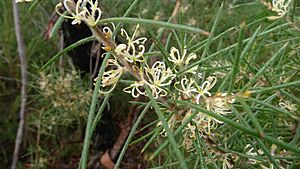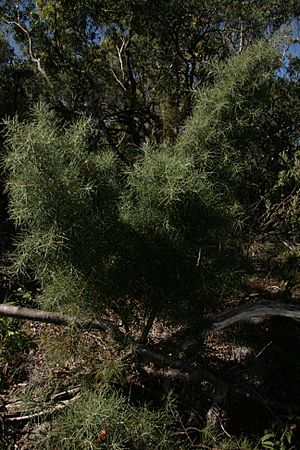Hairy hakea facts for kids
Quick facts for kids Hairy hakea |
|
|---|---|
 |
|
| Scientific classification | |
| Genus: |
Hakea
|
| Species: |
gibbosa
|
 |
|
| Occurrence data from AVH | |
| Synonyms | |
|
Banksia gibbosa Sm. |
|
The Hakea gibbosa, also known as hairy hakea or needlebush hakea, is a type of shrub. It belongs to the Proteaceae plant family. This plant is found only in south-eastern Australia, meaning it is endemic to that area.
Hairy hakea has very spiky leaves. It grows cream-yellowish flowers from April to July. These dense, prickly plants offer a safe place for small birds to hide. However, in places like South Africa and New Zealand, where it was brought in to be used as a hedge, it has become a problem plant. This means it grows too much and can harm the local environment.
Contents
What Does Hairy Hakea Look Like?
Hairy hakea is a very spiky shrub that can grow from about 1 to 3 meters (3 to 10 feet) tall. It can be bushy or thin. Unlike some plants, it does not have a special woody swelling at its base called a lignotuber. This means it cannot regrow from its base if the top part is destroyed.
When the plant is young, its new growth and leaves are covered with fine brown hairs. As they get older, they become smooth. The leaves look like needles and are usually grooved on the underside. They are about 2.5 to 8.5 cm (1 to 3.3 inches) long and 0.9 to 1.5 cm (0.35 to 0.6 inches) wide. They spread out in different directions and have a very sharp point at the end, about 1 to 2.3 mm long.
Flowers and Fruits
The flowers grow in groups of two to six. These cream-colored flowers appear where the leaves join the stem. Each flower group is on a small stem about 0.7 to 1.6 mm long. The individual flower stalks, called pedicels, are 2 to 5 mm long and covered with long, soft hairs. Hairy hakea flowers from April to July. The flower parts, called the perianth, are 5 to 6 cm long, white-yellow, and usually smooth.
After flowering, the plant produces large, grey, round fruits. These fruits are woody and measure about 2.5 to 4.5 cm (1 to 1.8 inches) long and 2 to 3 cm (0.8 to 1.2 inches) wide. Their surface is deeply wrinkled or bumpy. They have a small beak and delicate horns about 0.3 mm long. Each fruit holds two seeds and stays on the shrub for a long time.
How Hairy Hakea Got Its Name
The hairy hakea was first described by a scientist named James Edward Smith in 1790. He first called it Banksia gibbosa. Then, in 1800, a Spanish botanist named Antonio José Cavanilles gave it the name it has today, Hakea gibbosa.
Where Hairy Hakea Grows
Needlebush hakea is mostly found in the Sydney basin area of central New South Wales, Australia. It grows on sandstone ridges and cliffs in a type of open woodland called heathland. Here, it often grows alongside other native plants like red bloodwood, tea tree, dagger hakea, heath banksia, and conesticks.
Some plants found in Queensland that were once thought to be hairy hakea are now known to be a different species called Hakea actites.
Hairy hakea is considered a "Category 1 Plant" on the list of Declared Weeds & Invaders in South Africa. This means it is a serious problem plant there. It has also started to grow wild in the northern parts of the North Island in New Zealand, where it is called "naturalised."
Hairy Hakea and Other Living Things
The spiky leaves of the hairy hakea provide a safe shelter for small birds. They can hide from predators among the sharp needles. The seeds of the hairy hakea are a food source for the Yellow-tailed Black Cockatoo.
Growing Hairy Hakea
Hairy hakea can be grown in gardens if the soil drains well and it gets plenty of sunshine. It is known to be an easy plant to grow. However, its very prickly leaves might make some people not want to plant it.



